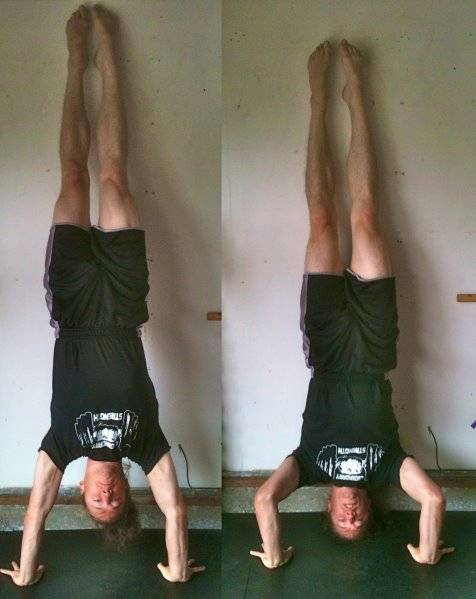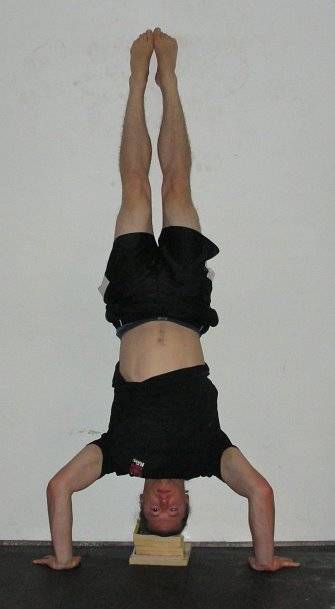When I first got involved in bodyweight training one of my main goals was to be able to do a single handstand push up against the wall. I had done things like the bench press before, but I was never very good at it. At that time, I was weak all over, but my upper body strength in particular was the weakest. Therefore, I knew if I could achieve this goal of a handstand push up that I would be on my way.
It took some time, but I did get there. It’s been many years and I have done a whole lot more since that first push up, including 22 handstand pushups against the wall in a single set, eight full-range handstand push ups (up on chairs, getting my hands to my shoulders), six freestanding handstand push ups, and a tiger bend. And it all started with that first rep.
In this article I’m going to give you ideas on how you can make handstand push ups easier or harder for you – no matter where you’re currently at. You see, most people are making a mistake with handstand push ups. They talk about it as if there is one way to do it and that it’s all the same. They are wrong!
Small modifications in your form with this exercise can make a huge difference in its difficulty. It can be the difference between being able to complete a rep or not. It can be the difference between able to rep them out or struggle through one rep. And all of this just depends on how you position your body.
The Truth About Handstand Push Ups
 Let me tell you how I discovered this truth. Almost ten years ago I was training in my garage gym doing a circuit of chin ups and handstand push ups. I had hit my rep goals with the handstand push ups touching my head to the floor, so I thought I was ready to start extending the range of motion of this exercise.
Let me tell you how I discovered this truth. Almost ten years ago I was training in my garage gym doing a circuit of chin ups and handstand push ups. I had hit my rep goals with the handstand push ups touching my head to the floor, so I thought I was ready to start extending the range of motion of this exercise.
I knew this would make it harder, but I wasn’t quite prepared for what took place. In order to add height I had to change my handstand position slightly from what I had been doing before. And when I tried, I couldn’t handle a single rep. I knew it couldn’t just be the height. So I eliminated the added height and replicated my new position, but this time on the flat ground. I managed to do a rep – but just barely.
What had occurred here? It’s actually quite simple. By changing my position, even though it was small, I changed my range of motion. Thus, I was doing a harder variation even without actually increasing the range of motion by putting my hands on a raised platform. So, that’s what I want to give you in this article – a couple ways to change the exercise to make it exactly as difficult as you need it to be. Here are the two ways I learned:
Increasing and Decreasing Range of Motion
 This is the ultimate key to handstand push ups. With a bodyweight exercise you are limited in how you can manipulate your weight, because basically you’re handling your full bodyweight at all times. Since you can’t change that, the main variable to play with, besides sets and reps, is the range of motion.
This is the ultimate key to handstand push ups. With a bodyweight exercise you are limited in how you can manipulate your weight, because basically you’re handling your full bodyweight at all times. Since you can’t change that, the main variable to play with, besides sets and reps, is the range of motion.
Note: I’m going to assume if you are reading this article you’re comfortable holding a handstand against a wall. If not, be sure to read my previous article on this topic.
The locked out handstand position is more of a support than a moving exercise. But from here we can start to move. Unlock the elbows just an inch then push back up. Is that easy? Then do two inches, then three and so on. The best way to make this measurable is to take a stack of books or something similar and put them under your head. To make it harder, you reduce the height of the stack. Here you have a progression that will get you to the ground.
And you can take it beyond that to work up to full-range handstand push ups. Now build up the height of what your hands are on so your head can lower deeper down. Eventually you can work to the full-range position, which I like to do between two chairs.
Changing Hand and Arm Position
 Now, let’s talk about how you can increase or decrease your range of motion just by changing your hand and arm position without any external objects. Typically in a handstand the hands are kept shoulder width apart. That’s good for a handstand, but it doesn’t need to be the case for handstand pushups. This exercise isn’t like regular push ups where you want to keep the elbows in to protect the shoulders. With the overhead angle the elbows can be kept in or flare out and your shoulders will be safe either way.
Now, let’s talk about how you can increase or decrease your range of motion just by changing your hand and arm position without any external objects. Typically in a handstand the hands are kept shoulder width apart. That’s good for a handstand, but it doesn’t need to be the case for handstand pushups. This exercise isn’t like regular push ups where you want to keep the elbows in to protect the shoulders. With the overhead angle the elbows can be kept in or flare out and your shoulders will be safe either way.
Taking a wider position is great for beginners or for someone just looking to do more reps. This is illustrated in the bottom picture. The reason for this is that it actually reduces the range of motion by a couple of inches. This reduces the range of motion about two or three inches. This may not sound like much, but it is. The reason why is that the sticking point for pressing is typically around the head. Therefore you’re eliminating the hardest part of the press here, which makes the exercise significantly easier.
Changing hand and arm position is just one of the ways you can manipulate your body position to make this exercise easier or harder. Increasing and decreasing range of motion also allows you to create useful progressions for yourself. When you combine these two methods with solid training, then you can become very strong in this exercise.
In case you missed it:
How to Work Up to a Handstand Against the Wall
How to Work Up to a Freestanding Handstand
How to Hold a Freestanding Handstand
References:
1. Christopher, L., “The Ultimate Guide to Handstand Pushups.” (Legendary Strength, 2009) pg. 18-19
Photos courtesy of Logan Christopher.






